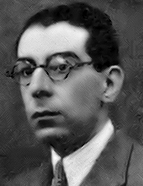

Historian, teacher, politician, and olissipographer with strong links to the Estado Novo, António Rodrigues Cavalheiro was born and lived virtually all his life in Lisbon. With a degree in Historical and Geographical Sciences from the Faculdade de Letras de Lisboa [ School of Arts and Humanities of Lisbon ], he was a teacher, first in secondary education and later at the Escola Naval [ Naval School ] , where he taught Maritime History.
Politically, he was a disciple and friend of António Sardinha, belonging to the second generation of Integralismo Lusitano [ Lusitanian Integralism ] (IL), like Manuel Múrias, César de Oliveira, Pedro Teotónio Pereira , and Marcelo Caetano. With them, he was involved in the creation of the magazine Ordem Nova in 1926, which marked the beginning of his departure from the movement, from which he had become disenchanted after Sardinha ’ s death. He left the IL for good in 1927, with the ambition, albeit brief, of reorganising the various monarchist integralist segments, materialised in the ephemeral idea of forming an “ Integralist Action League ” . Like so many others in the monarchist and traditionalist circles, he then drifted politically towards the Estado Novo (the PIDE considered him, according to a 1949 record, “ one of the most enthusiastic and zealous nationalists of all time ” ), under which he was a member of the National Assembly between 1942 and 1945 and a proxy in the Corporate Chamber from 1961 to 1965 on behalf of the men of the humanities . During the Salazar regime, he also held the positions of head of the Secção de Bibliotecas e do Arquivo Histórico da Câmara Municipal de Lisboa [ Libraries Section and Historical Archive of the Lisbon City Council ] (1932) and director of the Serviços Culturais da Mocidade Portuguesa [ Cultural Services of the Portuguese Youth] (1944).
This work is financed by national funds through FCT - Foundation for Science and Technology, I.P, in the scope of the projects UIDB/04311/2020 and UIDP/04311/2020.
